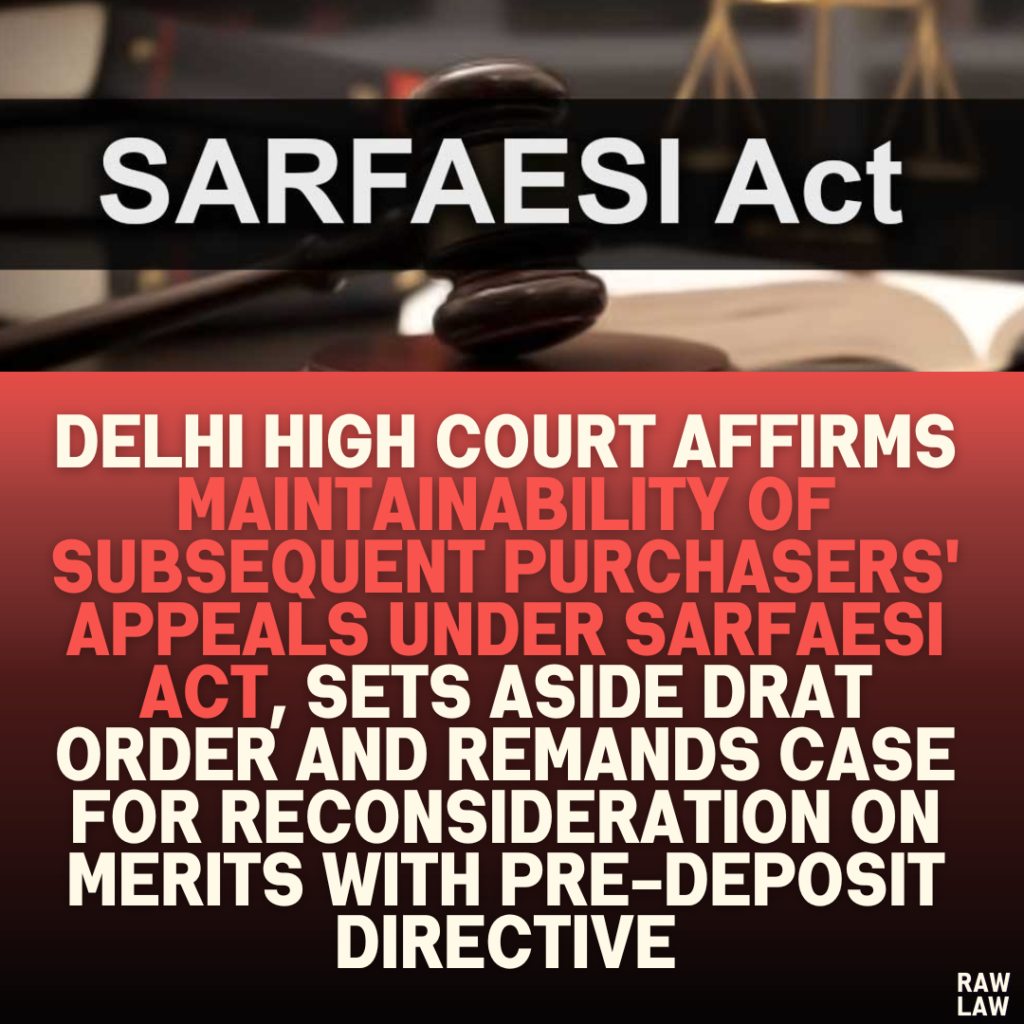Court’s Decision:
The Delhi High Court ruled that the Debts Recovery Appellate Tribunal (DRAT) erred in dismissing the appeal of subsequent purchasers on the grounds of maintainability. The Court held that appeals under Section 18 of the SARFAESI Act, 2002, are maintainable even if filed by subsequent purchasers of mortgaged properties. The matter was remanded back to the DRAT for reconsideration on merits, with a directive that the Tribunal may impose a pre-deposit condition if deemed necessary.
Facts:
- The petitioners purchased properties that were previously mortgaged by their original owners (borrowers) under a financial agreement.
- These properties became subject to auction proceedings under the SARFAESI Act due to defaults by the original borrowers.
- The petitioners filed an appeal before the Debts Recovery Tribunal (DRT), challenging the auction sale, but their appeal was rejected.
- They subsequently appealed to the DRAT, but the DRAT dismissed the appeal on the grounds that it was not maintainable since the petitioners were not original borrowers.
- The petitioners then approached the Delhi High Court, arguing that their appeal should have been considered on merits.
Issues:
- Maintainability of the Appeal: Can subsequent purchasers of a mortgaged property file an appeal under Section 18 of the SARFAESI Act?
- Dismissal Without Merit Consideration: Was the DRAT justified in dismissing the petitioners’ appeal without examining its substantive content?
Petitioner’s Arguments:
- The petitioners contended that as subsequent purchasers, they had the right to challenge the auction of the mortgaged properties under Section 18 of the SARFAESI Act.
- They emphasized that they were always ready and willing to make the pre-deposit required under the law.
- The petitioners alleged that the DRAT failed to examine the substantive merits of their case and erroneously dismissed the appeal solely on the ground of maintainability.
Respondent’s Arguments:
- The respondents admitted that appeals under Section 18 of the SARFAESI Act, filed by subsequent purchasers, are indeed maintainable.
- However, they contended that the DRAT had dismissed the appeal after considering all relevant submissions, implying that there were substantive grounds for the dismissal.
Analysis of the Law:
The High Court analyzed Section 18 of the SARFAESI Act, which governs appeals to the Appellate Tribunal.
- Who Can Appeal? Section 18(1) permits any “person aggrieved” by an order of the DRT to appeal to the DRAT, provided certain procedural and financial conditions (like pre-deposit) are met.
- Pre-Deposit Requirement: The section mandates that borrowers must deposit a portion of the debt amount before filing an appeal, but it does not restrict subsequent purchasers from filing an appeal.
- Judicial Interpretation: The Act does not differentiate between borrowers and subsequent purchasers concerning their right to appeal.
Precedent Analysis:
No specific judgments were cited in the document. However, the Court adopted a purposive interpretation of Section 18 of the SARFAESI Act to support its decision.
Court’s Reasoning:
- Error in Dismissal: The DRAT dismissed the appeal based solely on maintainability, holding that the petitioners, as subsequent purchasers, had no standing to file an appeal under Section 18. This reasoning was flawed as the Act does not impose such restrictions.
- Admittance by Respondents: The respondents themselves admitted that an appeal by subsequent purchasers is maintainable, further affirming the petitioners’ legal standing.
- Merits Unexamined: The High Court noted that the DRAT failed to consider the substantive merits of the petitioners’ claims, thereby depriving them of a fair hearing.
- Remand for Fresh Consideration: The Court remanded the case to the DRAT for a fresh adjudication of the appeal on merits, clarifying that the DRAT may impose a pre-deposit requirement if necessary.
Conclusion:
The High Court set aside the DRAT’s order, remanding the case for reconsideration on merits. It emphasized that subsequent purchasers have the right to appeal under Section 18 of the SARFAESI Act, provided they comply with procedural requirements. The Court refrained from expressing any opinion on the substantive claims made by the petitioners.
Implications:
- Recognition of Subsequent Purchasers: The judgment affirms that subsequent purchasers of mortgaged properties have standing to appeal under the SARFAESI Act.
- Fair Adjudication Mandated: Appellate bodies such as the DRAT must examine the merits of appeals and not dismiss them on erroneous grounds of maintainability.
- Clarity in Legal Procedures: The decision reinforces the rights of third parties in recovery proceedings and emphasizes procedural fairness.




Pingback: Bombay High Court Upholds Dharavi Redevelopment Re-Tendering: "No Concluded Contract Without Letter of Award; Government Can Cancel Tenders in Public Interest" - Raw Law